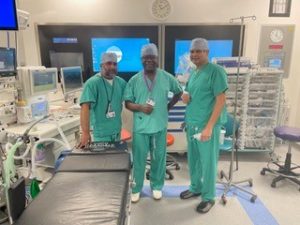Myoma (Fibroids)
On this page:
Uterine fibroids, also called myomas, are benign overgrowths of the muscle tissue in the uterus (womb). Other names for fibroids include uterine leiomyoma.
Fibroids are very common and it is estimated that around 20% of women (1 in 5) will have them during their lifetime. Further information about fibroids can be found here.
Symptoms:
Fibroids may not cause any symptoms at all. However, if they do cause symptoms, these can include:
- Heavy and/or painful periods
- Pain, pressure, or a feeling of “fullness” in the belly
- The need to urinate often
- Too few bowel movements (constipation)
- Difficulty getting pregnant
Fibroids do not always require treatment unless they are causing any of these symptoms. However, they can increase in size over time and symptoms may change or increase.
Symptoms tend to decrease after the menopause because the fibroids often decrease in size due to a reduction in levels of hormones in the body.
Fibroids are generally diagnosed after a doctor’s visit where your symptoms are explored and the doctor examines you.
A confirmatory ultrasound is usually requested. Occasionally a MRI scan is requested as well.
If your fibroids are growing rapidly and your symptoms are changing quickly or you experience weight loss or a new cough, you should see your doctor urgently as in very rare cases a presumed fibroid can change into a cancer called a Sarcoma.
Treatments
There are a range of treatments for fibroids which include:
A period of observation
If your symptoms are mild and not troublesome to you, you may not require any treatment at all, but we may recommend regular review with ultrasounds over time.
Treatments to decrease bleeding and pain
Treatments such as Tranexamic Acid and Mefenamic Acid and other ‘over-the-counter’ anti-inflammatory medications are often used as first line measure to help with your symptoms.
Hormone Medications
Occasionally medications containing hormones similar to contraceptive pills or injections, are tried.
Intra-uterine devices
Intra-uterine devices like the MIRENA device are also useful for some women mainly to decrease heavy bleeding.
Artificially induced menopausal state
Occasionally, an artificially induced menopausal state is created by your doctor with medications given via nasal spray or injections to help slow fibroid growth and even decrease their size and thus your symptoms.
If the above treatments are not suitable you may require a procedure or surgery.
Procedures
Uterine Artery Embolization
Uterine Artery Embolization is the least invasive procedure offered for treatment of Uterine Fibroids.
During the procedure, you will be awake but under sedation. A thin tube is inserted through your groin, and under x-ray guidance, the blood supply to your womb and therefore your fibroids is blocked using small particles. This causes the fibroids to stop growing, and may even cause them to shrink over time.
You would usually be admitted to the hospital for one night to have this procedure. Not everybody is suitable for this procedure, and your Doctor will discuss if this is right for you. Further information can be found here.
Surgery
A wide range of surgical treatments are available at St George’s. These can involve removing the whole uterus or surgery to removing just the fibroids.
These options are described below, and if you require surgery, your doctor will discuss the best options for you as all of the options described may not be suitable for everyone.
Transcervical Resection of Fibroids (TCRF)
Fibroids can be removed individually via a procedure that is done through the Vagina with no cuts or incisions on your abdomen. This is called Trans-Cervical Resection of Fibroids. This is recommended for fibroids that are protruding into the cavity of the womb and causing very heavy bleeding. This procedure is not suitable for all types of fibroids and your Doctor will discuss if this is an option for you.
Myomectomy
Fibroids can also be removed via surgery through your abdomen (tummy). This is called a Myomectomy.
If the fibroids are small, this procedure can be done via Laparoscopic or ‘Keyhole’ approach which involves three(3) or four (4) small (1-2cm) cuts on your tummy. Healing and recovery are quicker and time spent in hospital is also decreased with this type of surgery.
If your fibroids are larger, laparoscopic or ‘keyhole’ surgery may not be appropriate and abdominal surgery involving a bigger cut on your tummy would be offered (the cut is similar to that seen with Caesarean Section for delivery of a baby). If your fibroids are very large, a vertical midline cut up to, or above, your belly-button may be required.
The aim of a Myomectomy procedure would be to remove all the fibroids and to reconstruct your womb afterwards.
Myomectomy is generally offered to patients who may still wish to have children, and is not considered the best treatment for patients who have completed their family.
Further information can be found here.
Hysterectomy
Hysterectomy is considered the definitive treatment for fibroids. It involves surgical removal of the womb entirely, thus ensuring that the fibroids do not return.
It can also be done via a ‘keyhole’ approach or again if the womb is large, through abdominal incisions as described above. Your ovaries can be left untouched with this surgery and therefore you do have to undergo the menopause as a result of this procedure. The vagina is also left undisturbed and thus hysterectomy should not impact sexual function. More information can be found here.
The Myoma Service is led by Professor Isaac Manyonda and Mr. Hugh Byrne, Consultant Gynaecologists. Mr. Sourav Das, Consultant Gynaecologist, is also an integral member of the service.

Dr. Balpreet Duggal serves as the Clinical Fellow and Annette Marlow serves as PA to our service.
We also work very closely with the Interventional Radiology Service at the Trust.
Clinics take place in Clinic A, Ground Floor, Lanesborough Wing.


